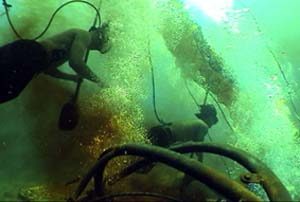Like the other two films in the trilogy, this work is shot underwater, with the participation of divers, and is accompanied by traditional music. A long, colorful dragon puppet symbolizing the traditional dragon of the Lunar New Year is carried by seven divers who progress in a type of submarine dance procession. Alongside the dragon appears a “Fate Machine” – a round, giant object resembling a lottery machine, which emits little balls upward with every rotation. After being shot up and before reaching the surface of the water, the balls split in two, releasing colorful powders – a dreamy vision that calls to mind submarine fireworks. The theatrical scene alludes to the terrible Tet Offensive of 1968, considered a turning point in the Vietnam War, when the North Vietnamese forces launched a surprise attack on the South during the Lunar New Year celebrated by both parties, causing great destruction and death. The “Fate Machine” reflects the element of surprise, and the balls cut in half symbolize both the lonely souls departing from this world, and the struggle and hope of the “boat people” who fled Communist Vietnam in multitudes after the war. The split ball and the scattering clouds of powder in fact analogize the release of the last breath from the body.
Nguyen-Hatsushiba takes upon himself a social role of preserving the memory of the past and honoring the anonymous dead who were forgotten. What appears at first like slow submarine choreography of forms and colors is revealed as a sensitive metaphorical translation of the harsh events of the past in Vietnam and in Japan. The consistent decision to shoot under water is due to the symbolism and great significance attributed to the sea by citizens of both countries. Water is perceived as a source of food, a major transportation route, and a historical echo for those thousands of “boat people” from the Vietnam War. Nguyen-Hatsushiba’s works, which have scored international success, combine ethnic and historical background, visual and poetical manifestations shot under water, and the use of advanced technology.
Jun Nguyen-Hatsushiba (1968) was born in Japan. Lives and works in Vietnam.
Courtesy of Mizuma Art Gallery, Tokyo, Lehmann Maupin Gallery, New York, and the artist.
Commissioned and produced by the MATRIX Program at the UC Berkeley Art Museum and Pacific Film Archive, Berkeley, CA with assistance from The New Museum of Contemporary Art, New York
Less Reading...
